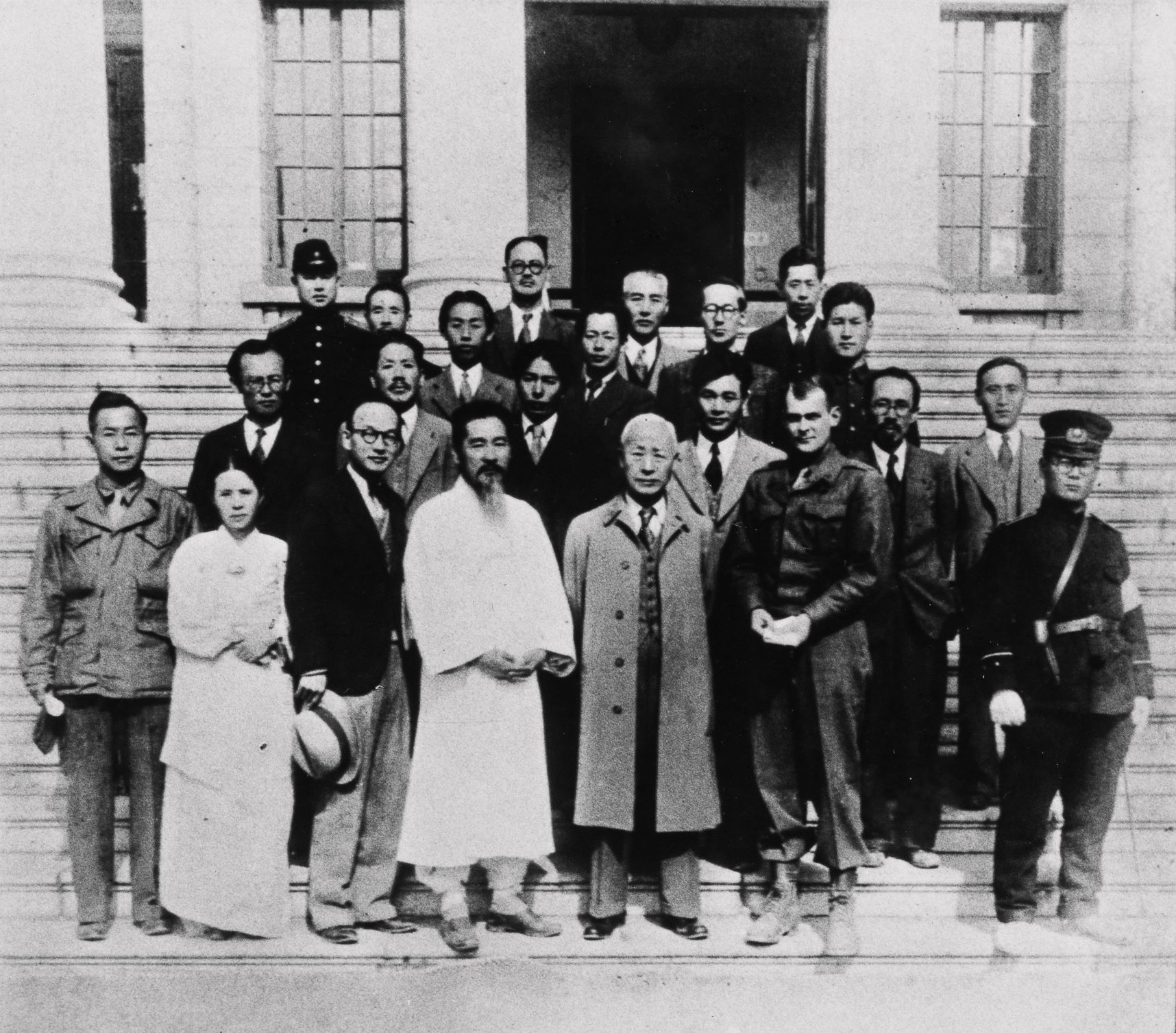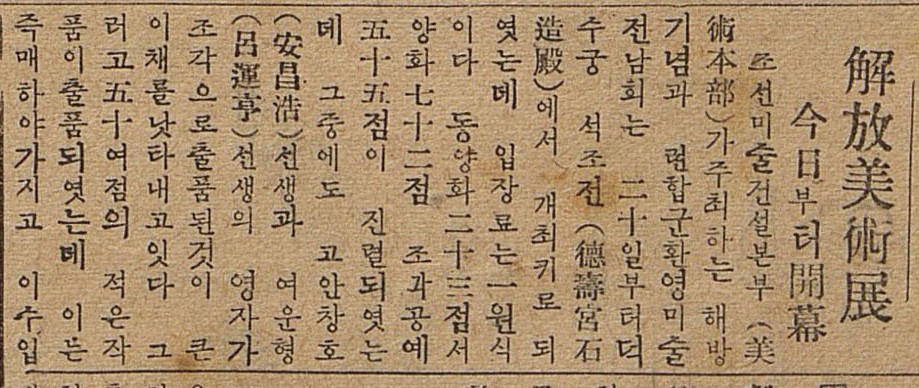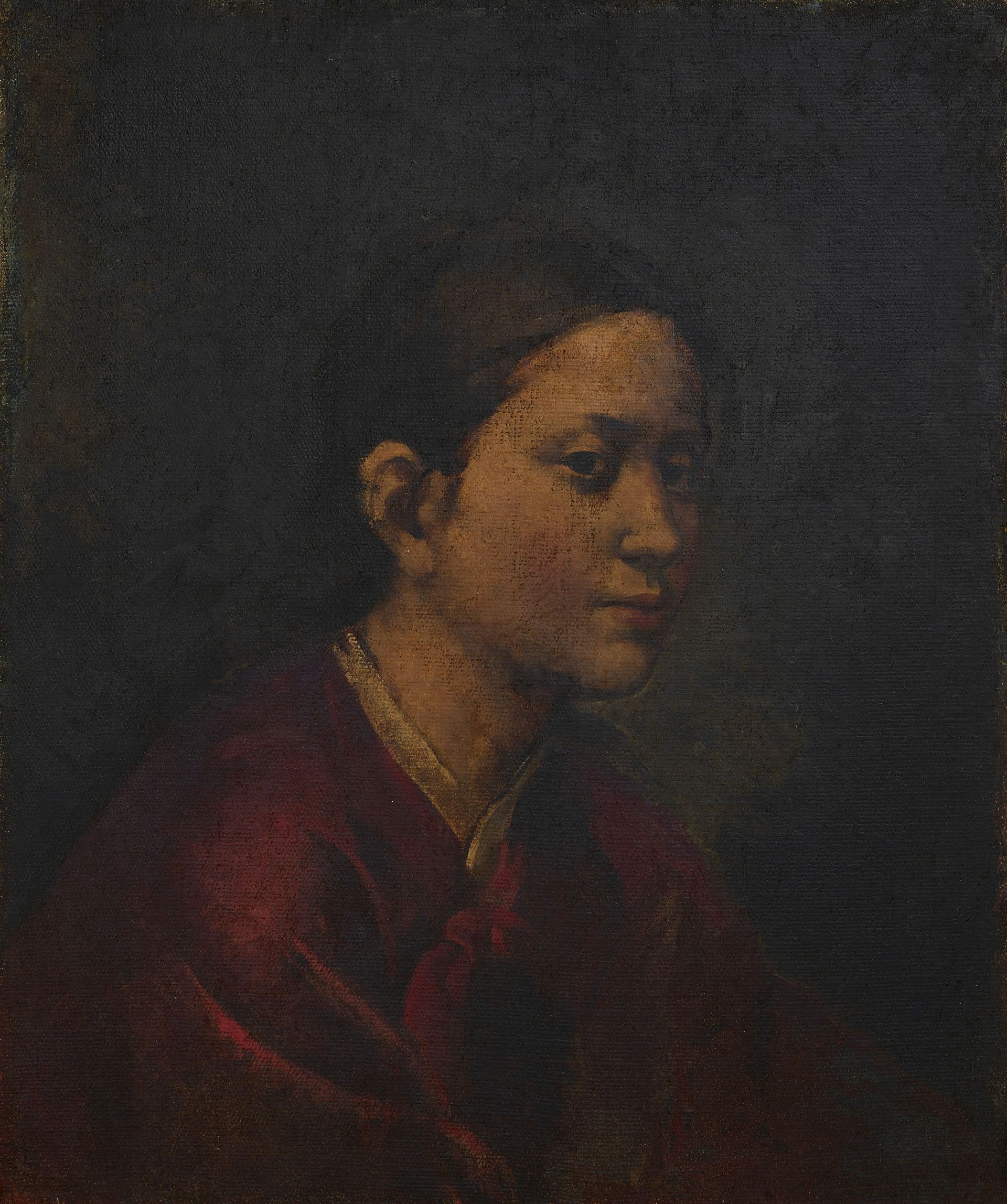
Photos of Artists in the Liberation Period, 1945, MMCA Art Research Center Collection, Gift of Kim Boggi
Liberation period
* Source: Multilingual Glossary of Korean Art by Korea Arts Management Service
Related
-

Korean Art Construction Headquarters
An artist organization established in August 18, 1945 and dissolved November 20, 1945. The founding of the organization was led by Kim Jukyung, Jeong Hyeonung, Gil Jinseop, and Yoon Hee-soon. The organization was one of the five divisions of the Central Committee for the Construction of Korean Culture [Joseon munhwa geonseol jungang hyeobuihoe] which included literature, art, music, film, and theater. The goal of the headquarters was the “new and unified building of Korean art,” and Ko Huidong was designated as the head commissioner. The Headquarters was the largest art organization after independence, comprising a total of 186 artists in six different divisions; Eastern Art, Western Art, Sculpture, Crafts, Children’s Art, and advertisement art. The first activities of the Korean Art Construction Headquarters [Joseon misul geonseol bonbu] after its establishment included the creation of banners, portraits, and national flags for the welcoming parade to celebrate the arrival of Allied Forces. From October 20th to 29th, 1945, the headquarters held the first Art Exhibition for the Celebration of Independence and the Welcoming of the Allied Forces. The exhibition featured 23 works of Eastern-style art, 72 works of Western-style art, and 55 works of sculpture and crafts produced by about 90 artists. After the dissolution of the Headquarters, right-wing members including Ko Huidong established the Korean Art Association [Joseon misul hyeophoe] in 1945.
-

Korean Proletarian Fine Art Federation
An organization established in 1945 that was aligned with socialist ideology. The name of the federation was changed to Puromimaeng shortly after its establishment, before being again changed to the Korean Art Alliance (Joseon misul dongmaeng). The alliance promoted proletarian art and advertised its work on the streets and at factories, and it also criticized the beliefs and lack of principles of the Korean Art Construction Headquarters (Joseon misul geonseol bonbu), the largest art organization at the time. The alliance followed a clear political ideology and aesthetic, and following the dissolution of the Korean Art Construction Headquarters (Joseon misul geonseol bonbu), it absorbed many of the formers’ artists into its ranks. Its membership, however, lacked influence in the art community, and as a result the alliance was ineffectual and disbanded in 1948.
-

Korean Artist Federation
An organization formed in February 1946 under the leadership of Kim Jukyung, Lee Insung, and Oh Chiho, who had recently left the Korean Art Association (Joseon misul hyeophoe). Additionally, numerous members of the Korean Art Alliance (Joseon misul dongmaeng) also joined the organization. The president of the Korean Art Association, Ko Huidong, became a member of the Citizens Emergency Council, a group closely aligned with Rhee Syngman, despite his claims to political neutrality. This drew criticism from the artists of the Korean Artists Association and provided the impetus for the establishment of the Korean Artist Federation (Joseon misulga dongmaeng). The governing body was the Central Executive Committee, which oversaw seven departments: the Painting Department, Art Critique Department, Children’s Art Department, Art Education Department, Performing Arts Department, Sculpture Department, and Crafts Department. The organization followed a five-point doctrine: First, eliminate the remnant influences of the Japanese Empire; second, reject all nationalistic and decadent artistic trends; third, establish a new movement of national art; fourth, form a partnership with the international art community; and fifth, attempt to achieve enlightenment of the general population through art and the education of future artists. The inaugural exhibition was from June 24 to June 31, 1946, at the Hwasin Gallery. In addition to exhibitions, the group also engaged in the production of promotional art, such as posters for the Democratic People’s Front.
Find More
-

Lee Qoede
Lee Qoede (1913-1965) was born in Chilgok, Gyeongsangnam-do as the second son of a wealthy landowner family. He was strongly influenced and supported by his brother, leftist intellectual Lee Yeoseong and specialized in the history of art, clothing, and folklore. He graduated from Soochang Elementary School in Daegu in 1928, Whimoon High School in 1933, and the Department of Western Painting at the Teikoku Art School in Japan. His works, such as Fate (1938), Night Picnic (1939), and Swing (1940), were selected for the Nikakai Exhibition. After his return to Korea, he founded and led the New Artists Association and its exhibitions from 1941 to 1944. After independence, he was appointed as a committee member of the painting division at the Korean Plastic Arts Federation [Joseon johyeong yesul dongmaeng] and a chairman of the Western Painting division at the Korean Art Alliance [Joseon misul dongmaeng]. After visiting North Korea, he became a centrist and founded the Korean Art and Culture Association [Joseon misul munhwa hyeophoe]. where he was appointed as a chair. In 1948, he joined the National Guidance League. While working as a lecturer at Hongik University, the Korean war broke out, after then and he contributed to the Korean Art Alliance. He escaped Seoul just prior to the 1950 September operation to retake the city but was arrested by the South Korean army and held in prison camps in Busan and Geoje. In an exchange of prisoners, he opted to go to North Korea. In 1988, when the ban on artists who defected to North Korea was lifted, his family revealed his works, such as the People series, A Beggar, and Fate, to the public. He then was re-evaluated as one of the most significant artists in Korean modern art history.
-

Korean Plastic Arts Federation
An organization formed in 1946 by numerous established artists. The core membership included Jeong Hyeonung, Gil Jinseop, Kim Kichang, Kim Man-hyeong, Lee Qoede, and Yoon Hee-soon, who left the Korean Art Association (Joseon misul hyeophoe) because of their opposition to the right-wing beliefs of Ko Huidong. The association was the parent organization of the Independent Art Association, Dangu Art Academy, Cheongahoe, Joseon Sculptors Association, and Korean Craftspersons Association (Joseon gongyega hyeophoe). The alliance held exhibitions and published bulletins, but about eight months after its establishment, it merged with the Korean Artist Federation (Joseon misulga dongmaeng) to form the Korean Art Alliance (Joseon misul dongmaeng). The Korean Plastic Arts Federation (Joseon johyeong yesul dongmaeng) was a rare politically moderate organization that accepted many artists in a national art community that was sharply divided along right-wing and left-wing divisions.
-

Korean Art Alliance
An organization created in 1946 in North Korea. as the result of a merger between the socialist Korean Artist Federation (Joseon misulga dongmaeng), the politically moderate Korean Plastic Arts Federation (Joseon johyeong yesul dongmaeng), the Joseon Sculpture Association, and former members of the Korean Art Association (Joseon misul hyeophoe). Together, these associations collaborated to host an Independence Cultural Art Exhibition and founded the Korean Art Alliance (Joseon misul dongmaeng). The Alliance actively conducted enlightenment activities under the doctrine of “Art for Public Awareness” and leftist artists were the primary members. The leadership of the Alliance was comprised of Yoon Hee-soon, Lee Insung, Oh Chiho, and Gil Jinseop. The Alliance’s doctrines included the implementation of democracy, departure from the influences of imperialism, establishment of National Art, and the enlightenment of the populace. The Alliance engaged in raising public awareness about modern art through activities such as street exhibitions, touring exhibitions, and the production of posters and leaflets. The Korean Art Alliance (Joseon misul dongmaeng) was an influential faction within the art community of the 1940s, raising public awareness about art and issuing statements on political events before disbanding in 1948.






